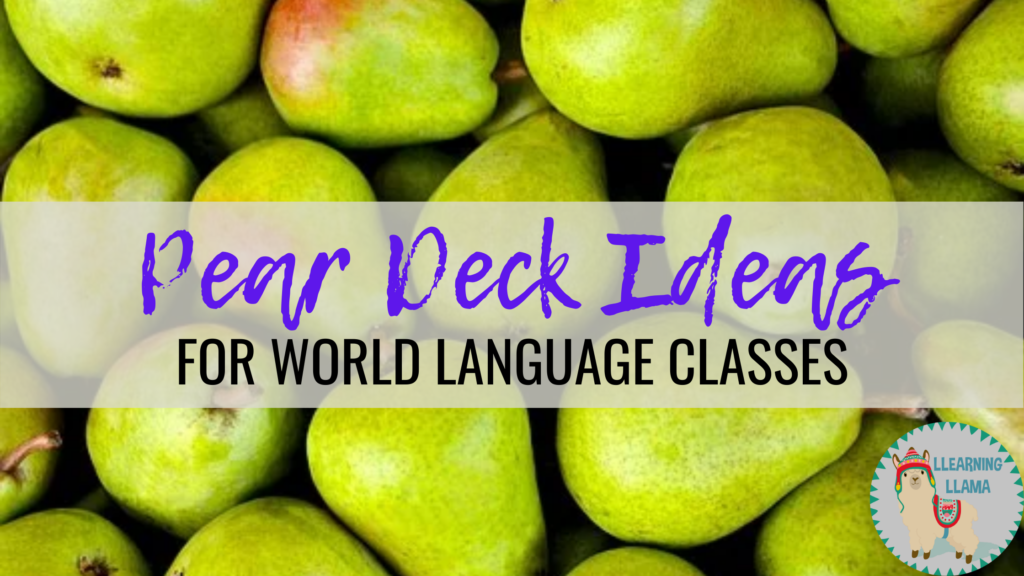Pear Deck has been one of the most effective virtual learning tools I’ve experimented with during this crazy year as a Spanish teacher! But have you been wondering how to use Pear Deck in Spanish class? World language teachers will find that they can use the Google Slides Pear Deck Add-On for any lesson. You can keep an eye on every student’s response at the same time, provide instant feedback, and easily update old Slides or PPTs to interactive Pear Decks! Check out my tips for how to use Pear Deck and practical ideas for virtual learning in Spanish class below with example slides!
What is Pear Deck? And why is it so great?!
Pear Deck is an add-on to Google Slides presentations that allows you to create interactive presentations for your classes. You can take a pre-existing Google Slides and add interactive questions so that you can simultaneously see every student’s response as you go through the presentation! You can create questions for multiple choice, drawing, writing, matching, and more! You simply share the live code with your students and they open the presentation on their screen.
If you want to go through the presentation with the students during a live class, choose “Instructor-paced.” You click through the slides and advance the presentation. With the Teacher Dashboard, you will see who has responded, who has not yet responded, and what each response is! You can provide instant feedback, as well!
If you want students to complete the activity on their own, choose “Student-paced,” and they will advance through the presentation by themselves, but you will still receive a copy of their results!
How to use Pear Deck in Spanish Class?
- Comprehensible Input – This is how I’ve been using Pear Deck most often this year. I create slides presentations to introduce new content. Start with your essential questions and use those to guide the presentation. For example, start the presentation with your first EQ “¿Cuáles animales están en peligro de extinción?” Then you have a few slides with names and images of the animals. You speak in the target language and describe the animals in detail. Then you repeat the question “¿Cuáles animales están en peligro de extinción?” on an interactive slide and let students respond. Maybe there are a bunch of images on the screen: cow, llama, jaguar, turtle, and they circle the ones you spoke about. The interactive activities should get progressively more difficult to where they write out an answer to that EQ.
- Grammar – Sometimes students need to practice grammar with fill-in-the-blanks or multiple choice. That practice helps them form habits and understand the grammar rules. You can choose any grammar concept and create a Pear Deck with scaffolded questions. Start it simple with questions that ask students to identify the correct sentence. “Ella es cómica” or “Ella está cómica.” Advance the difficulty of the questions by having them fill in the blanks, write their own sentences, and more! Check out my Verbs Like Gustar Pear Deck here. Or Present Tense Regular Verbs practice here. Or Por vs. Para Pear Deck!
- Vocabulary – This is a great pre-reading strategy or review of unit vocabulary. Slides could contain images and students write in the word that corresponds or vise versa! Students have the ability to draw on the slides, similar to Pictionary! You can have text on the screen and students identify the vocabulary terms in the text and annotate or respond to questions with vocab terms. As always, start with simple questions, by giving them choice: El volcán es _____ porque emite humo y ceniza. (activo o inactivo).
- SEL Check-in – We can embed social emotional check-ins to every Pear Deck presentation. They can be related to how well students understood the lesson, how they are doing today, or what they are excited for this weekend! Throw in some questions throughout the presentation to break it up and to get to know your students.
- Reading Comprehension – Ask review questions like you would on Kahoot or Quizlet Live based on a text you have read. Questions can be True/False, Fill in the blank, short answer, etc! This is great practice for a quiz!
This sounds great! But, what types of questions can I ask?
- Matching questions – Students can draw lines to match images with vocabulary terms
- Illustrations – Write a sentence on the slide and students must illustrate it. “La manzana está encima de la mesa.” Or the other way – you put the drawing and students write out a sentence
-
Draw the Number – You can create audio for your slides and embed it. So students listen to you and they have to write down the number they hear.
- Draggable icons – You can ask a multiple choice question or a 4 corners question and students are given an icon to drag to respond! Here is a frequency words Pear Deck (siempre, nunca, etc.)










One Response